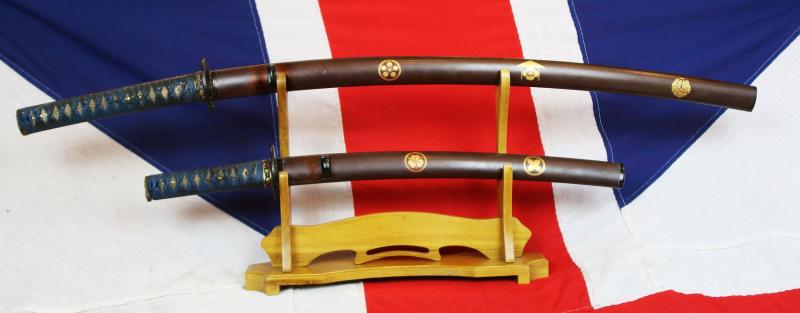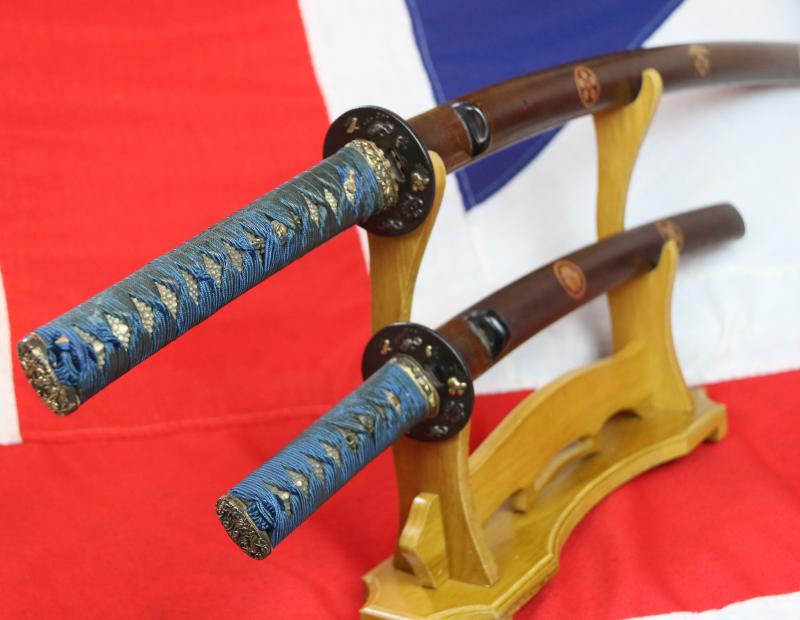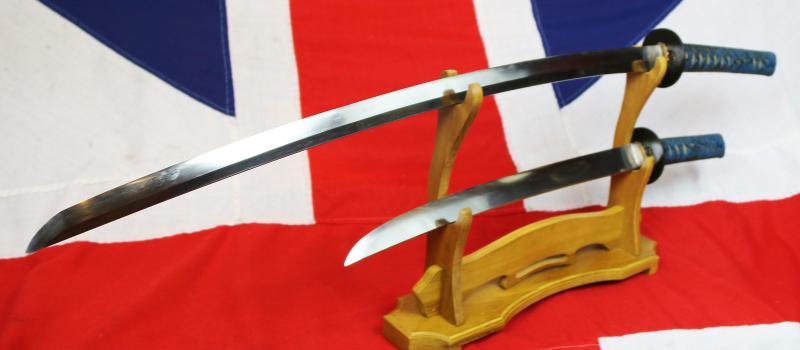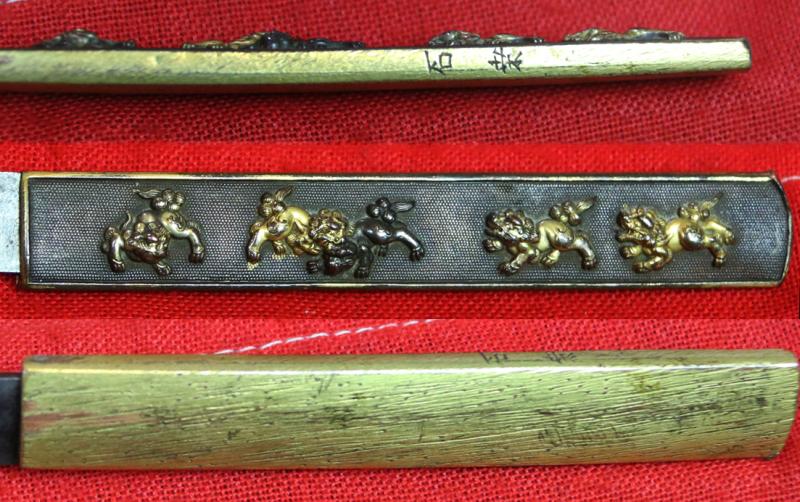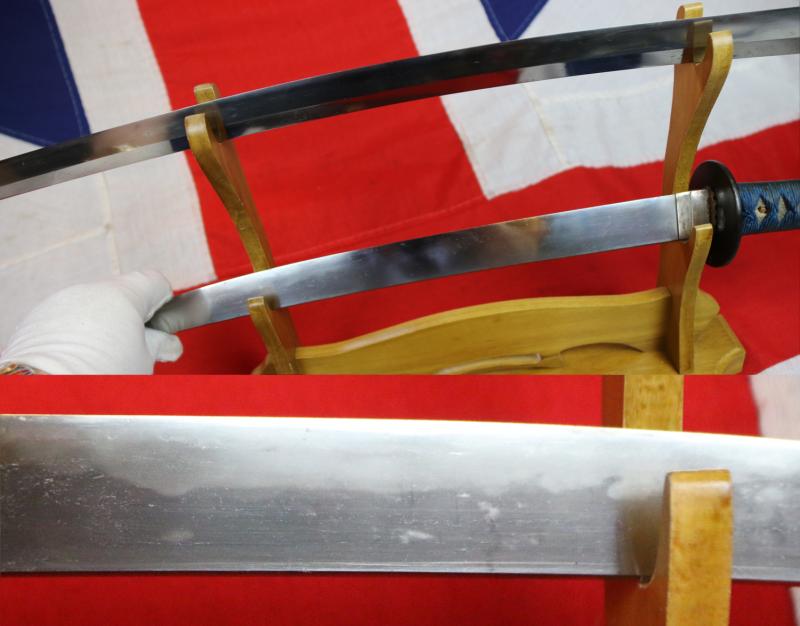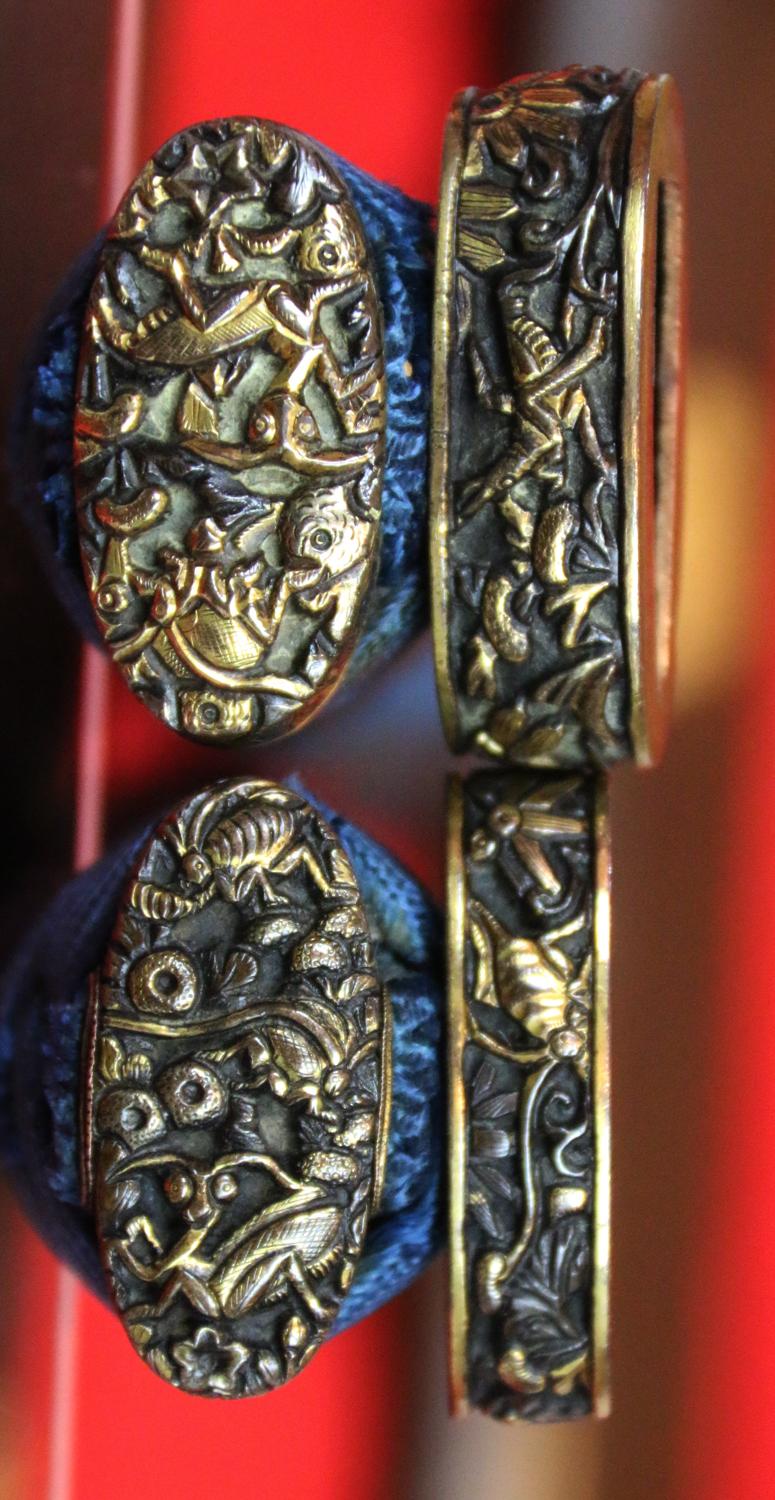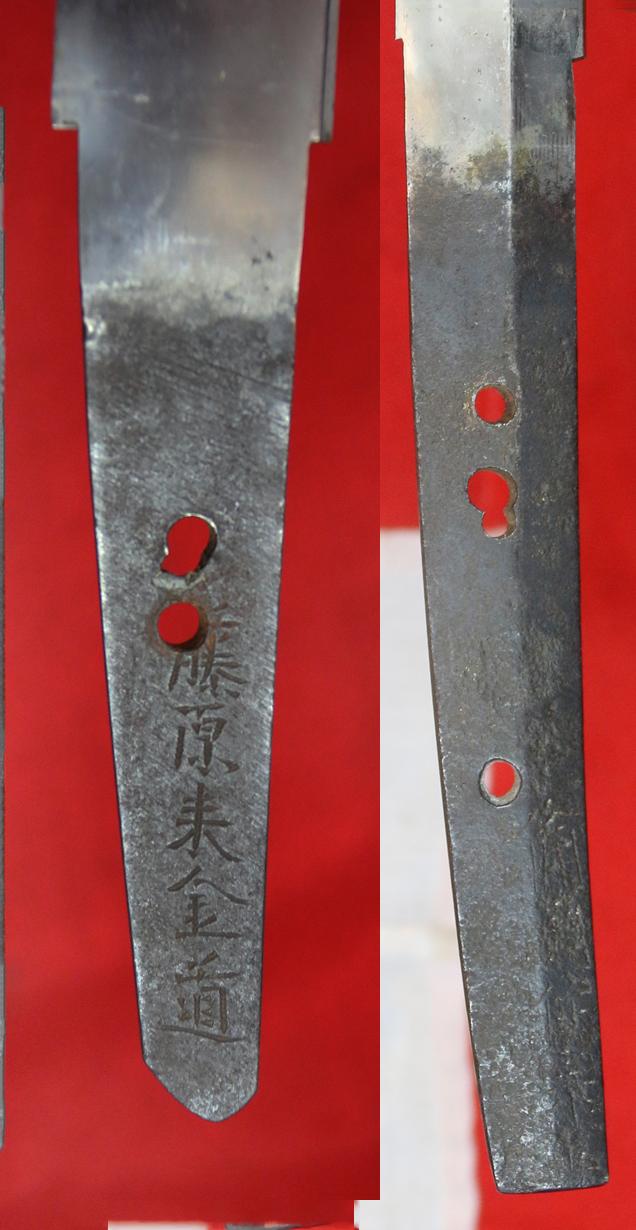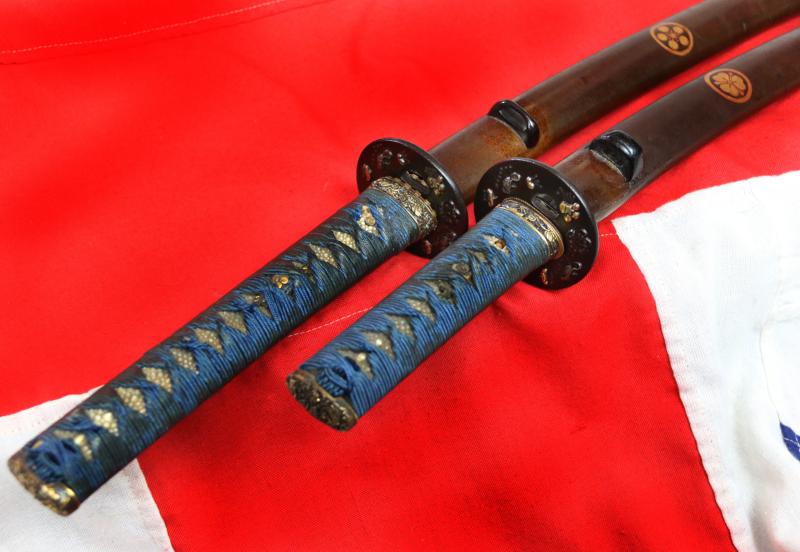A Fine Kugyō Daisho, Koto to Early Shinto Era, Of A Daito & Shoto. Daito Signed Bishu ju Munemitsu. Shoto Signed Fujiwara Rai Kinmichi Yamashiro. This Daisho Is One Of The Most Beautiful Pairs Of Original Edo Period Fitted Samurai Swords We Have Seen
A fabulous daisho likely of the highest ranks of the samurai nobility of ancient and feudal times, they held the highest status of samurai in Japan and the rank of Kugyō. The samurai lords and controllers the Shogun’s court of the bakufu, only ranking below the shogun himself
The blades and saya have now returned from no expense spared *museum grade conservation, so we show them now after it has been completed. The perfectly colour matching brown and gold silk sageo tied around the daito saya, that we have been saving for just such a deserving sword as this, after we acquired it from Victor Harris decades ago, looks absolutely incredible.
The Daito {long sword} bears the signature: Bishu ju Munemitsu, Bizen Province, Late Mihara school, circa 1575, Gunome hamon Masame hada
The Shoto {short sword} is signed: Fujiwara Rai Kinmichi, Yamashiro School, {circa 1624}, Sudareba hamon, Masame hada. A beautiful suite of daisho fuchgashira of takebori insects and catydids in gold and shakudo, and a pair of fabulous iron plate maru-gata tettsu tsuba inlaid with takebori flower heads in soft metals. The most fine kozuka, is in gold and shakudo takebori, decorated with shishi {lion dogs}, over a nanako ground, is signed, and its steel blade, kozukatana is also signed
The daisho have finest original Edo saya, of urushi lacquer decorated with kamon of multiple clans, this suggests affiliations and allegiance to those clans, and they are multiples of mon applied, on a ground of gold-nashiji, of gold-ikakeji. This form of highest superior work was restricted, in feudal times, to san mi 三位, samurai owners, of the third court-rank, or possibly even higher, such as 一位, Ichii, First rank, or, 二位, Nii, second rank. These samurai nobles of the third to higher ranks were called kugyō when these two swords was made and carried in the early Edo period of the Tokugawa shogunate.
First Rank (一位, Ichii): The highest court rank, reserved for individuals of exceptional merit and influence.
Second Rank (二位, Nii): A higher rank, often associated with those in positions of authority.
Third Rank (三位, Sanmi) and Fourth Rank (四位, Shii): These ranks denoted important positions in the court system
In feudal Japan, court ranks, known as mibun, were a hierarchical system defining the status and duties of individuals, particularly within the samurai class. These ranks influenced everything from a samurai's attire and position to their ability to request audiences with the Shogun. The system was a complex tapestry of colors, symbols, and titles, signifying one's place in the social order.
In the Tokugawa shogunate each of the First to Third Ranks is divided into Senior (正, shō) and Junior (従, ju). The Senior First Rank (正一位, shō ichi-i) is the highest in the rank system. It is conferred mainly on a very limited number of persons recognized by the Imperial Court as most loyal to the nation during that era.
The Junior First Rank (従一位, ju ichi-i) is the second highest rank, conferred in many cases on the highest ministers, premier feudal lords, and their wives.
Nobles with the Third Rank or upper were called kugyō.
Successive Tokugawa shoguns held the highest or near-highest court ranks, higher than most court nobles. They were made Shō ni-i (正二位, Senior Second Rank) of court rank upon assuming office, then Ju ichi-i (従一位, Junior First Rank), and the highest rank of Shō ichi-i (正一位, Senior First Rank) was conferred upon them upon their death. The Tokugawa shogunate established that the court ranks granted to daimyo by the imperial court were based on the recommendation of the Tokugawa shogunate, and the court ranks were used to control the daimyo.
Oda Nobunaga and Toyotomi Hideyoshi were Shō ni-i (正二位, Senior Second Rank) and Ju ichi-i (従一位, Junior First Rank) respectively, but both were elevated to Shō ichi-i (正一位, Senior First Rank) in the Taisho era, about 300 years after their deaths.
The no expense spared museum grade conservation including blade polish conservation and cleaning, has yielded fabulous results. We undertook it for two specific reasons, firstly, it deserves to be returned to as close to its original condition as possible, yet, still showing it age, and, externally regarding the tsuka-ito and urushi lacquer, showing all its natural wear, and secondly, to honour its previous owner, who, for several decades, was a seasoned practitioner of the Japanese martial art forms {not using these swords of course}, and he was a friend of many in the Japanese nihonto world, such as Victor Harris, former Curator of Japanese swords at the British Museum. It has thus been undertaken with immense care. For example all the original urushi nashiji lacquer is being left, just, ‘as is’ after it has been hand cleaned and conserved, in order to show all its natural beauty, quality yet natural aging, with its colour somewhat darkening from the past few hundred years.
Every single item from The Lanes Armoury is accompanied by our unique Certificate of Authenticity. Part of our continued dedication to maintain the standards forged by us over the past 100 years of our family’s trading, as Britain’s oldest established, and favourite, armoury and gallery.
THE LANES ARMOURY, THE PREMIER HOME OF ORIGINAL AND AFFORDABLE ANCIENT ANTIQUITIES & MILITARY ANTIQUE COLLECTABLES IN BRITAIN.
The Lanes Armoury, is world renown as Britain's favourite specialist collectors shop, and also a font of historical and educational information that is detailed with every single item. We detail each piece alongside its historical context, either generic or specific, for those that may wish to read, learn, or be informed, as opposed to simply acquire collectable items. We are probably one of the oldest companies of our kind in the whole of Europe and we have been established through generations, as specialists in armoury, military antiques, militaria collectables, and specialist books, since the early 1900’s, and thus we have continued to be one of the largest in the world today. The current partners were set on this path by their great grandfather
We are also very pleased to know we are also studied and read by academics and students from hundreds of universities around the world, by those that are interested in not only British but worldwide history. Of course we are not perfect and errors can and will be made, but thanks to our viewers and visitors, errors can be corrected, and learnt from.
Our sacred principle is that every single country's history ought to be studied, learnt, and passed down to future generations, however good, or even bad, some of it may be. All history is knowledge, be it good, bad, or indifferent.
Everyday we are contacted by historians that wish to make contributions to our detailed information for our pieces, and to thus add to our constant dedication to impart historical knowledge, that may be unknown to many of our millions of viewers.
As once told to us by an esteemed regular visitor to us here in our gallery, in order to view and study our Japanese edged weapons and armour gallery, and the same words that are repeated in his book;
“In these textures lies an extraordinary and unique feature of the sword - the steel itself possesses an intrinsic beauty. The Japanese sword has been appreciated as an art object since its perfection some time during the tenth century AD. Fine swords have been more highly prized than lands or riches, those of superior quality being handed down from generation to generation. In fact, many well-documented swords, whose blades are signed by their makers, survive from nearly a thousand years ago. Recognizable features of the blades of hundreds of schools of sword-making have been punctiliously recorded, and the study of the sword is a guide to the flow of Japanese history.”
Victor Harris
Curator, Assistant Keeper and then Keeper (1998-2003) of the Department of Japanese Antiquities at the British Museum. He studied from 1968-71 under Sato Kenzan, Tokyo National Museum and Society for the Preservation of Japanese Swords.
* Museum grade conservation is encouraged for fine and rare artefacts in order to conserve and create pieces as much as is possible without creating an ‘as new’ appearance. It is extremely important to retain as must original patina as possible, and natural aging, so as to beautifully improve their current condition as much as possible, without removing historical context. Such as the great priceless treasures, the Roman Portland vase, and the Anglo Saxon Sutton Hoo helmet, associated with King Rædwald of East Anglia, now both exhibited in the British Museum
The original lacquer saya on the shoto has small areas of line opening near the throat due to its past hundreds of years old wear, yet it is still in a fine condition otherwise. Its hand carved and polished black buffalo horn fittings and kurikata are are now hand repolished and superb throughout the daito saya. This overall museum grade conservation project we have undertaken, involving hundreds of hours of expert attention and skill, we would like to think, is just the kind of result that our friend, Victor Harris, formerly of of the British Museum, would have been proud.
Code: 25805
Price
on
Request

